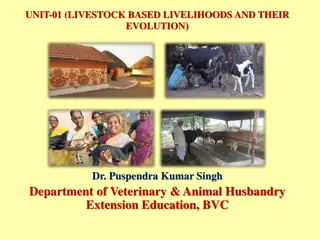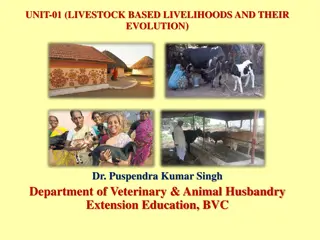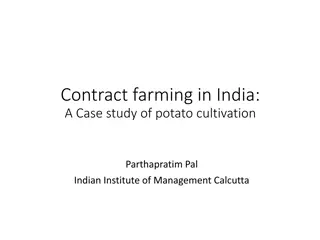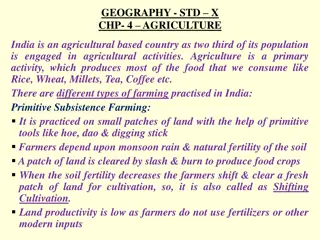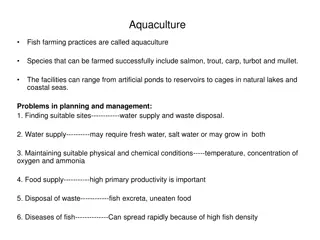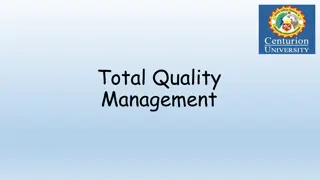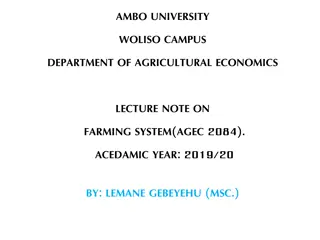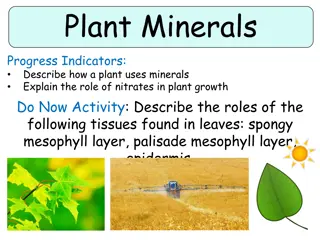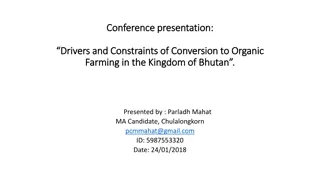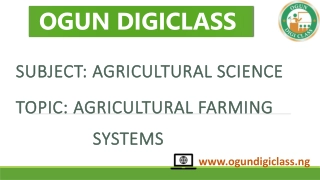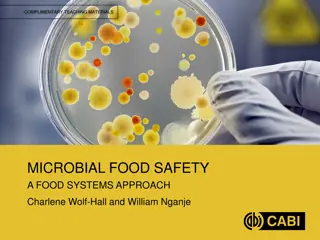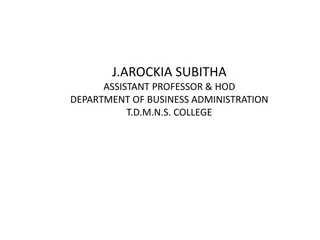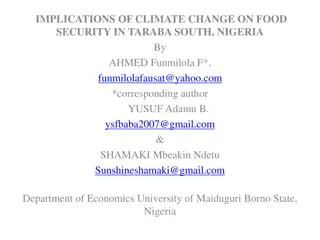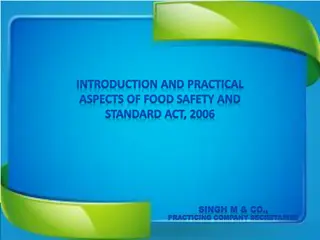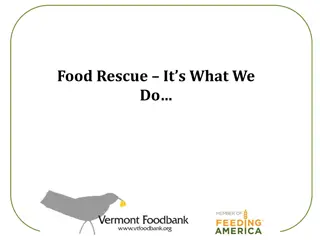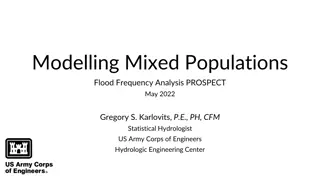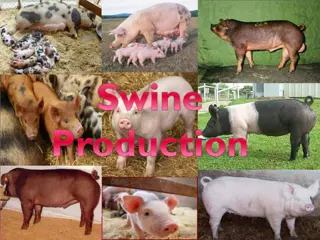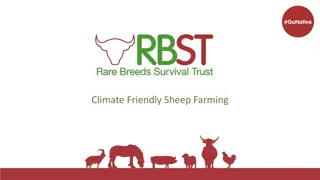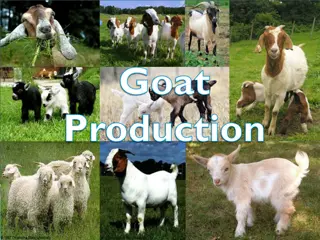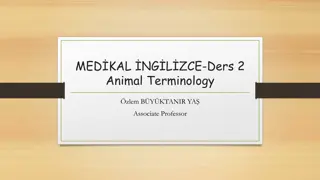Enhancing Food Safety and Quality in Mixed Farming Systems
Food safety practices are crucial in preventing contaminants and food-borne illnesses, while maintaining food quality is essential for consumer satisfaction. Good Agricultural Practices (GAPs) and Good Veterinary Practices (GVPs) play key roles in ensuring safety and quality. Smart farming technologies like data collection help enhance food safety and reduce waste. Proper storage facilities are vital for preserving crop quality and profitability, with recommended moisture levels for long-term storage in high-temperature regions highlighted.
Uploaded on Sep 17, 2024 | 0 Views
Download Presentation

Please find below an Image/Link to download the presentation.
The content on the website is provided AS IS for your information and personal use only. It may not be sold, licensed, or shared on other websites without obtaining consent from the author. Download presentation by click this link. If you encounter any issues during the download, it is possible that the publisher has removed the file from their server.
E N D
Presentation Transcript
Intellectual Output 1: Mixed Farming System (MFS) e-Book Section 5: Food and safety
Food and safety Food Safety practices ensure the prevention of contaminants and food- borne illnesses during preparation, handling, and storage, keeping consumers safe Food Quality is defined by the features and characteristics of the food that make it acceptable to the consumer, including appearance, flavour, texture, pricing, and nutritional information Good Agricultural Practices (GAPs) and Good Veterinary Practices (GVPs) are essential to ensuring Food Safety and Food Quality, as they boost the production of safe and quality foods and ensure appropriate levels of quality and safety in animals used for human food production Smart farming, which involves collecting temperature, humidity, and chemical data, is a valuable tool for enhancing food safety and reducing waste and contamination episodes
Good Agricultural and Veterinary Practices GAPs ensure a certain standard of food quality. It includes: The selection of appropriate land and quality seeds The usage of authorised and acceptable chemical substances like fertilisers and pesticides in adherence to guidelines. GVPs suggests slaughtering healthy animals administered safe-to-use drugs according to legislation. GAPs and GVPs protect food from contamination by extraneous materials, toxic chemicals, and environmental pollution excessive or unsafe levels of agricultural chemical residues, pests, and biological contamination.
Preservation of Agricultural Goods Proper storage facilities, such as cooling storage, are crucial for preserving crop quality and achieving productive and profitable production. Temperature, moisture, and oxygen content are the factors that heavily affect grain degradation and the speed of development of insects and microorganisms Temperature and moisture levels should be below threshold values, while low- oxygen environments can halt the development of microorganisms and insects and grain degradation Microorganisms, insects, and rodents are the primary decomposers of stored grain Insect infestations can cause significant losses and compromise the quality of stored grain Rodents can infect and reproduce in or near storage places and cause serious losses and health risks
Table 2-1 and 2-2 show recommended moisture levels for long-term storage in high- temperature regions
So, what happens when fruits and vegetables are harvested? Harvested fruits and vegetables deteriorate quickly because they are still living parts of a plant and continue with their respiration process Ethylene, produced by harvested fruits, is responsible for speeding up the process of fruit ripening and tissue degradation Storing ethylene sensitive crops with crops that produce high levels of ethylene should be avoided Lowering the temperature can mitigate the problem of fruit decay by slowing down the rate of crop metabolism and activity of microorganisms Cooling storage facilities (stationary or movable) can extend storage life, maintain crop quality, and reduce deterioration Practices that improve the efficiency of cooling storage include adequate handling, preliminary cooling, and proper management of storage conditions Pre-cooling is an essential practice to remove field heat as soon as possible, particularly for highly perishable crops Each crop has its own storage requirements regarding temperature, humidity, and compatibility with other crops
What is meat quality? Meat quality is a complex concept with various characteristics: Yield and composition Technological characteristics Palatability Wholesomeness Ethical quality Tenderness and intramuscular fat (IMF) are important eating quality characteristics. IMF varies from small lipid cells to heavily marked fat islands in the muscle (marbling). The proportion of marbling has proven to be of great importance to the meat sensory characteristics. Consumers agree that well-marbled beef is both juicy and tasty.
What is meat quality? IMF develops differently in cattle depending on genotype, gender, age, and feeding. Crossbreeding dairy cows with beef bulls results in calves with higher weight gain and a more efficient conversion of feed energy to carcass weight. Growing calves need high dietary concentrations of protein with high protein quality. Grass silage constitutes the basis for beef cattle feed rations.
Environmental impact Methane from feed digestion is of similar or larger importance for climate impact. Higher daily weight gain reduces methane emissions calculated per kg meat produced. Using cattle with higher feed efficiency and lower mortality fed with a well- balanced diet can substantially contribute to environmental improvements. Emissions of climate gases per kg meat could be reduced by around 15% by a combination of measures, where using crossbreeds were one of the most important measures. Resource-efficient Swedish systems, including sex-sorted semen and beef breed crossings, have promising results in reducing emissions of climate gases per kg meat.
Meat preservation Meat is affected by endogenic enzymatic activity (proteolysis) and slowed down by cold Primary chilling is necessary for effective meat preservation Chilling must be done quickly to prevent microbial growth and deterioration Air-based chilling is the most common method Flash cooling can cause cold shortening and toughening of the meat The time required for chilling can be reduced by gradually lowering the temperature of the air or gradually increasing air speed, but poses risks and higher costs. Cold chambers must have low air temperature, high airspeed, high humidity, and high refrigerating capacity


